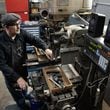Back in 1968, the year the Woodruff Arts Center first opened its doors, Midtown Atlanta was thought of as a place where only hippies and drug dealers would hang out.
But the visionary business, political and community leadership of almost 50 years ago saw something else. They saw opportunity. They believed that if our city was truly to become a global community, it needed to offer world-class options in several areas including, importantly, the arts.
In the ensuing decades, with the Arts Center as a beacon, Midtown transformed. It became a dynamic, livable community for business, housing, recreation, education and a variety of arts and cultural attractions. Those leaders nearly 50 years ago knew they had to take some chances and invest if Atlanta was to grow. Their investment paid off.
Today, Atlanta is facing a similar, though larger, dilemma: where and how should we invest to cement Atlanta’s role as a truly global city and the gateway to the South?
Since I’m not an expert in urban planning or development, I won’t pretend to know the complete answer to the question. I’ll just offer what I think is important to businesses, families or tourists considering Atlanta as a potential place to relocate or visit.
We are, indeed, blessed with some world-class answers, particularly those areas where our leaders have invested taxpayer dollars. Our airport is the busiest in the world. We have great academic and research-based institutions that provide a steady stream of young talent. Piedmont Park and the Atlanta Beltline offer green space and recreational opportunities. Children’s Healthcare of Atlanta is one of the best pediatric health care systems anywhere. We have two professional sports franchises building new stadiums. All these community assets receive some state and/or local taxpayer support.
But in other areas, we fall well short of world class. The challenges with mobility, transportation infrastructure and our schools are well known. Thankfully, these issues are getting focused attention from today’s leaders.
But the arts deserve support and attention as well.
The Woodruff Arts Center has grown into the third-largest arts center in the U.S. and it continues to produce great art at the Alliance Theatre, the Atlanta Symphony Orchestra and the High Museum of Art. But opportunities are limited and challenges are very real because the arts are almost entirely dependent on private support.
Today, the state of Georgia ranks 50th – dead last — among all states in support for the arts. Just a small infusion of taxpayer money would make a huge difference in assuring that the arts can continue to thrive, not only at the Woodruff Arts Center but across the entire arts community.
Every great city touts its quality of life in order to attract new investment. International investors and visitors, in particular, place a very high premium on the arts in their assessment of quality of life. Like transportation, green space and health care/research, the city and state need to invest in the arts to assure that Atlanta’s quality of life continues to measure up.
About the Author





